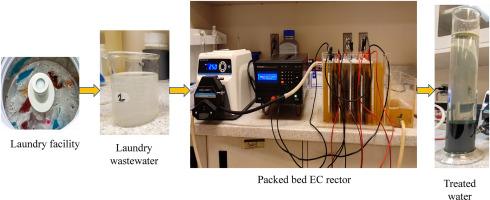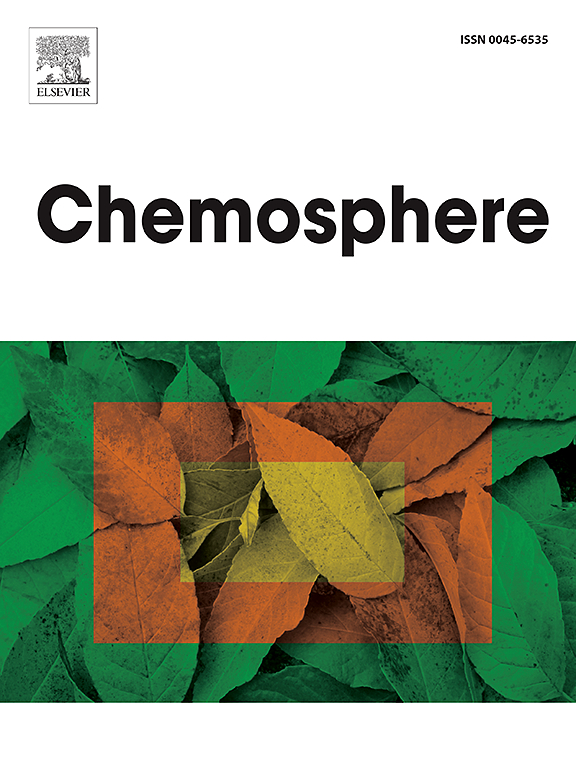使用牺牲铁电极的填料床电凝法在商业洗衣废水处理中应用中心复合设计。
IF 8.1
2区 环境科学与生态学
Q1 ENVIRONMENTAL SCIENCES
引用次数: 0
摘要
本研究论文论述了一种利用填料床电凝法(PBEC)处理商业洗衣废水(LWW)的新方法,该方法由牺牲铁电极和用作絮凝剂的细胞外高分子物质(EPS)组成。该研究采用不锈钢阴极、石墨阳极和废铁片作为牺牲电极,确保在动态批处理模式下进行高效处理,并通过蛇形流促进接触时间。LWW 的初始特性为 COD 579 ± 30 mg/L、TSS 60 ± 10 mg/L、TS 622 ± 20 mg/L、浊度 110 ± 5 NTU、pH 9 ± 0.5、NPEOs 570 ± 150 μg/L、电导率 494 ± 20 mS/cm。结果表明,在优化电流强度为 2.99A、处理时间为 58.8 分钟、EPS 剂量从 5.8 mg/L 提高到 8.0 mg/L 的条件下,浊度(98 ± 2%)、TS(95 ± 3%)、COD(89 ± 5%)和 NPEOs(53 ± 2%)的去除率均得到了提高。经济可行性分析表明,能耗是主要支出,处理成本为 1.20CAN 美元/立方米。这项研究介绍了商业生活污水的可持续处理方法,符合魁北克省的回用标准,意味着回用潜力和负责任的污水管理。本文章由计算机程序翻译,如有差异,请以英文原文为准。

Application of central composite design for commercial laundry wastewater treatment by packed bed electrocoagulation using sacrificial iron electrodes
This research paper deals with a novel method utilizing packed bed electrocoagulation (PBEC) comprising of sacrificial iron electrodes and coupled with extracellular polymeric substances (EPS) used as flocculent agents for the treatment of commercial laundry wastewater (LWW).
The study employs stainless steel cathodes, graphite anodes, and scrap iron pieces as sacrificial electrodes, ensuring efficient treatment in dynamic batch mode operation with enhanced contact time facilitated by serpentine flow. The initial characteristics of LWW were COD 579 ± 30 mg/L, TSS of 60 ± 10 mg/L, TS of 622 ± 20 mg/L, turbidity of 110 ± 5 NTU, pH of 9 ± 0.5, NPEOs of 570 ± 150 μg/L and conductivity of 494 ± 20 mS/cm. The results demonstrate effective removal of turbidity (98 ± 2%), TS (95 ± 3%), COD (89 ± 5%), and NPEOs (53 ± 2%) under optimized current intensity: 2.99 A, treatment time: 58.8 min and enhanced EPS dose from 5.8 mg/L to 8.0 mg/L. The economic feasibility analysis reveals energy consumption as the primary expenditure, with a treatment cost of 1.20$CAN/m3. This research introduces sustainable treatment for commercial LWW, meeting Quebec's reuse standards, implying reuse potential and responsible wastewater management.
求助全文
通过发布文献求助,成功后即可免费获取论文全文。
去求助
来源期刊

Chemosphere
环境科学-环境科学
CiteScore
15.80
自引率
8.00%
发文量
4975
审稿时长
3.4 months
期刊介绍:
Chemosphere, being an international multidisciplinary journal, is dedicated to publishing original communications and review articles on chemicals in the environment. The scope covers a wide range of topics, including the identification, quantification, behavior, fate, toxicology, treatment, and remediation of chemicals in the bio-, hydro-, litho-, and atmosphere, ensuring the broad dissemination of research in this field.
 求助内容:
求助内容: 应助结果提醒方式:
应助结果提醒方式:


